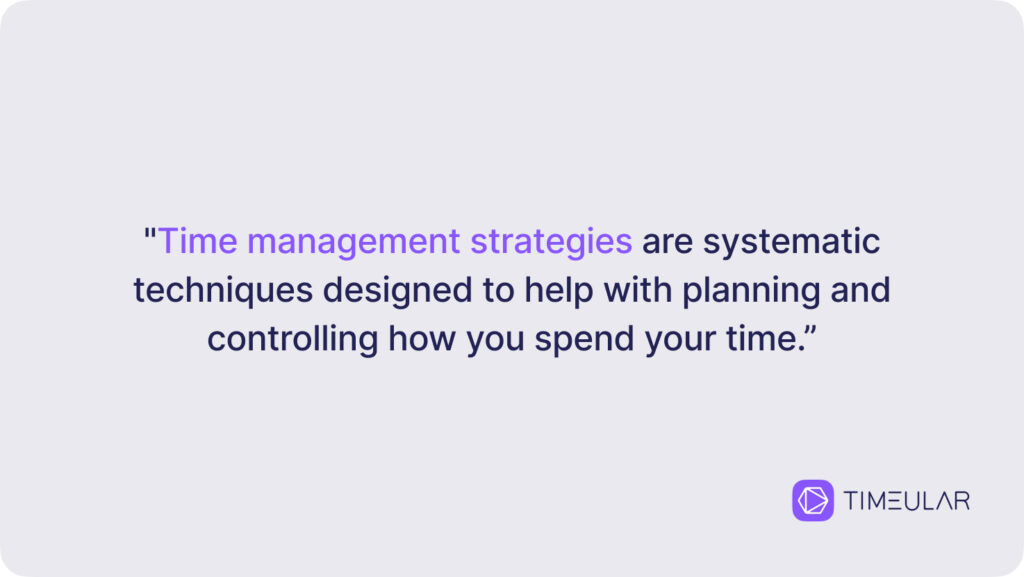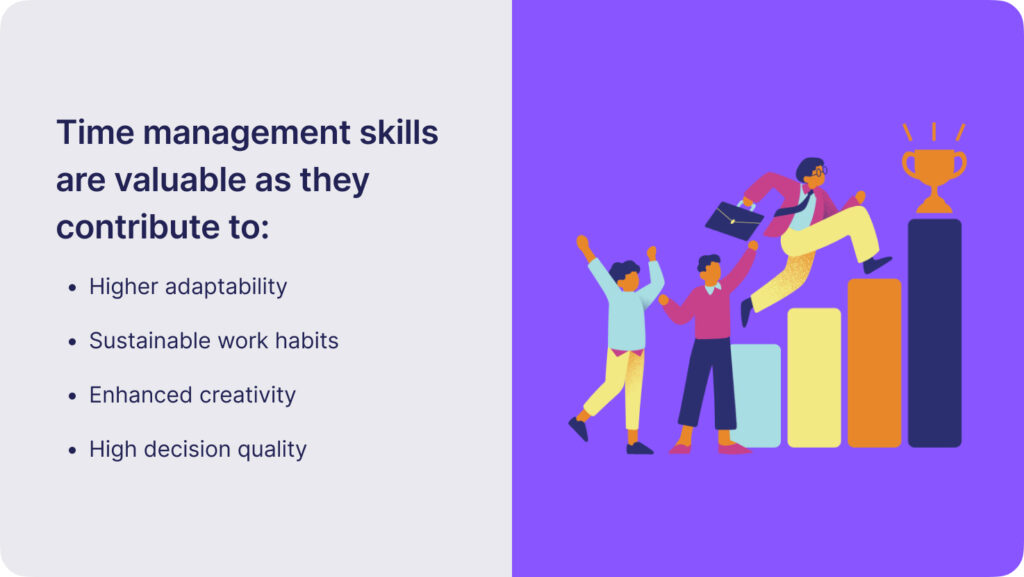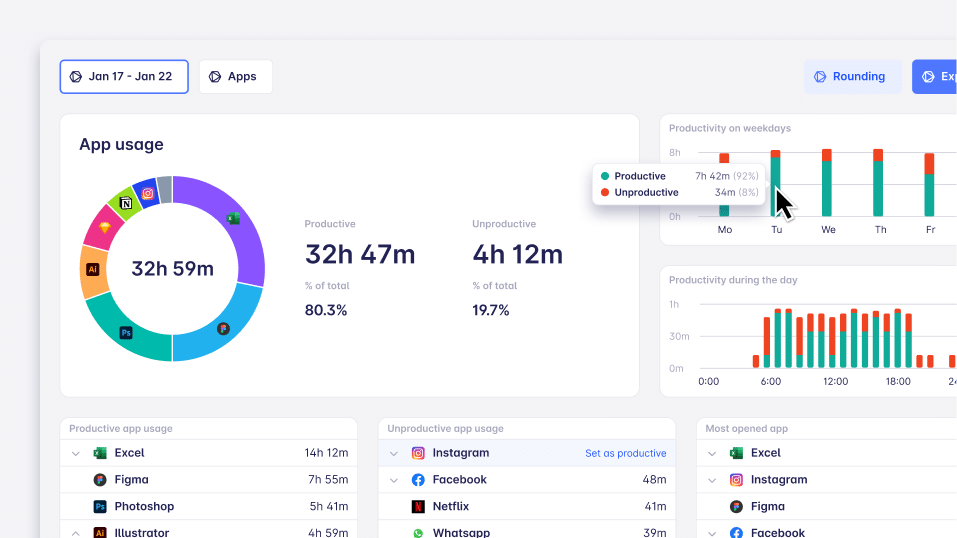10 Proven Time Management Strategies [With Real-Life Examples]
If you’re here, you’re not merely content with how you’re organizing your time.
Time has the tendency to get away – but you need to find the delicate balance between rallying to keep up with all requests while keeping your sanity.
For this, you have time management strategies. But how do you embed these strategies into everyday life? I’ve prepared a guide for you with the following:
The ins and outs of time management strategies
Concrete examples of time management strategies applied by our CTO, Growth Manager and Senior Content Marketer
An illustration of how time management strategies can be used in real life by looking at examples from Barack Obama, former president Dwight D. Eisenhower, or Steve Jobs
What are time management strategies?
Time management strategies are systematic techniques designed to help with planning and controlling how you spend your time. Time management strategies are the backbone of productivity, project success, and career fulfillment. When applying effective time management strategies, you can reduce your stress levels and keep your work-life balance.
Time management strategies give you the ability to:
Own your time (time allocation will become a breeze).
Prioritize urgent tasks and not only.
Challenge your poor time management habits.
➡️ Not ready to start your own time management strategy just yet? Learn about why it’s important to set realistic goals.

What makes time management skills valuable?
Each year, we work for approximately 240 days, which translates into 1,920 hours. I’ve expanded on this topic in the article about how many work days there are in a year.
Work demands are increasing, and we’re trying to handle them while we are spread thin and in undeclared competition with technology. Burnout and depression are on the rise, so you need to apply any strategy that’s not only keeping us afloat, but that helps us thrive in our professional and personal lives.

Successful time management skills contribute to the following:
Higher adaptability: Once you have a good grasp of time management, you know how to effectively respond to unexpected challenges or a change in priorities. Knowledge really is power in situations that require high adaptability skills – imagine yourself knowing exactly what time management technique to apply in a crisis situation without feeling overwhelmed.
Sustainable work habits: Marathons are cool, but they’re exhausting your system, so as work needs to happen from Monday to Friday, being on a marathon is not sustainable for your physical and mental health. The weekend will not save you, but sustainable techniques will be applied constantly during the work week.
Enhanced creativity: A structured time management framework frees up mental space for innovative thinking and problem-solving. When you escape the run-of-the-mill work lifestyle, you foster your creative muscles and unlock innovation and disruption.
High decision quality: An effective time management relationship also allows you to think through your decisions and reflect and analyze more. So your decision’ quality is better-informed, rather than relying on rushed judgments.
Additional read: A collection of time management statistics
Time management strategies
1. Make a to-do list (aka “knockout” list)
Start each day or week by creating a “knockout” list. Pinpoint your top priorities, specific tasks that need to get done first.
Make this list a priority and a promise you must keep to yourself that you’ll have the self-discipline to get those things done by the timeframe you’ve awarded for yourself. It’s a rapid planning method with no risks involved.
A great example of making such hard promises to himself is serial entrepreneur, investor, and host of “The Profit” Marcus Lemonis. Lemonis has physical note cards in his closet. He makes a list of the five things he wants to get done that day and makes them without exception. Lemonis writes these cards in the morning, which fires his motivation and gives him a sense of purpose.
The most interesting part of Lemonis’s strategy is that, in the end, he makes paper airplanes out of his cards to give himself a physical signal that the task is checked off.

Using an automated time management app surfaces your time-spending habits and helps you organize your time better
2. Prioritize tasks like former President Eisenhower
Prioritizing like the 34th President of the US should definitely lead to good results. In fact, the time management matrix (or the urgent, important matrix), as it is often called, is one of the most sought-after time management strategies, and for good reason.
The Eisenhower Matrix is a game-changer for task prioritization. It guides you to declutter all the pressure you’re awarding to all tasks by categorizing them into urgent and important tasks. This way, you save time and maximize productivity as your paramount tasks are clear, and you focus on what truly matters.
You can prioritize tasks based on the following categories:
Do First = Urgent and important tasks
Schedule = Important, not urgent tasks
Delegate = Urgent, not important tasks that can be done by someone else
Delete = Delete not important, not urgent tasks (routine tasks can be part of this category)
These effective time management tips should clarify your priorities and boost productivity. By tackling high-impact tasks first, you’re choosing a straightforward yet powerful technique to master your time management.
- Recommended read: What is a DuPont schedule?
3. Use time management tools
A time-tracking app helps you surface your time-spending habits, identify time wasters, and, in the end, manage your time better based on data. Time management tools are centralized platforms in which you track work progress automatically so you can focus on your most important tasks.
Imagine a time management tool as an objective report or a time audit. Timeular, for example, does the following:
Sends you AI-generated time entry suggestions based on your calendar events and past entries, so you don’t forget to fill your timesheet and have a realistic overview of your daily tasks;
Generates easy-to-digest reports showing your productivity trends, time spent on client projects, and different activities so that you can identify patterns of efficiency;
Tracks your work in the background and automatically adds in your time tracker all work you’ve performed based on app, website, and document usage. Rest assured, you have 100% data control.
This is a preview of a report that surfaces smart productivity insights:

4. Start the day with your onerous tasks
An effective time management technique that you can apply in your daily schedule is starting with the most difficult task. This is the Eat the Frog method.
Originated by Mark Twain, the eating the frog method involves starting the day or the week with the most challenging or important task. This is one of Karolina’s favorite and most productive techniques:
” My favorite time management strategy? Start the day or week with the least pleasant task. This technique, called “eat the frog,” ensures I complete all my to-do list tasks, not just the ones I find interesting.” Karolina, Senior Content Marketer @Timeular.

5. Protect your time by blocking it
Another great strategy for managing your time is scheduling valuable time for specific tasks that require your attention and deep work.
A time block is a designated period during which you allocate specific tasks or activities to focus on. By allocating dedicated time blocks for each activity, whether it’s work-related tasks or personal activities, you create a structured framework that enhances focus. With this technique, you’re also preventing distractions and multitasking so you can concentrate fully on one task at a time.
Our Growth Manager, Matilde, uses time blocking as the main time management technique, as she’s juggling many responsibilities:
“My role at Timeular requires me to wear multiple hats: sometimes I am a copywriter, other times a data specialist or a campaign strategist. Also, I want to be a great team buddy for my colleagues. Next to it, I am also a first-time mum, so I need to be present also for my new little family. The multiple responsibilities require me to stay organized and lucid. I prioritize the most important tasks in the morning and block time in my calendar to execute them. In this way, I make sure I’m tackling my to-do list with ease.”
6. Manage focus and energy instead of time
Sometimes, the best time management strategy is not managing time at all but other things like energy and focus.
It’s easy to book your time accordingly and use all the advice from motivational speaker Tony Robbins or other gurus, but it’s much harder to predict the circumstances when your focus and energy are at their top. So, instead of managing your time, manage your focus and energy.
Being aware and realistic about your circumstances goes a long way than pushing endlessly until you’re depleted of energy. Ask yourself questions such as:
When am I most creative or energetic?
When could I schedule break time for mindless admin activities?
How can I align my most demanding tasks with my peak energy times?
Are there specific environments or conditions that enhance my concentration and productivity?
How can I structure breaks throughout the day to sustain my energy levels?
Designate blocks of time when you’re most energic and have the highest ability to focus on deep-dive into difficult tasks and projects or brainstorm ideas. Having a time management plan makes it easier to stay on task and ignore distractions.
TIP: Consider implementing the 2 2 3 schedule to manage your team’s time.

7. Set a time limit for a specific task
Setting time limits to different tasks primes your mind in a mental state of productivity and focus. The method that you can apply here is the Pomodoro technique. This method involved working intensely for 25 minutes, followed by a 5-minute break. You can tackle your daily tasks in this way, by adding bursts of focus, followed by a short break.
This is my favorite method, as it helps me see small achievements and task completion in manageable tasks during an entire day. I also feel like it helps me reduce stress and task-switching ( checking Slack, my phone, or emails), which is disrupting my focus on a regular basis.
It can fire your motivation and prevent burnout while you’re seeing constantly that work expands into checked-off tasks.
8. Group interruptions
Mastering time management can mean avoiding meetings at all costs or grouping any interruption between certain timeframes so you can focus on other tasks that require attention. On that note, did you know… that employees spend 16% of their time in useless meetings? An MIT study proved that.
An interesting concept from computer science called “interrupt coalescing” implies that computers, in the back end, are grouping interruptions based on priorities. In order words, if you’re giving your computer a command, it will assess its priority and group it into different priority batches. If the computer has the resources and identifies them as paramount to handle, it handles it; if not, it adds it to a queue.
You can tell that our CTO has a similar approach, too, right?
“As a CTO and head of product, managing a broad spectrum of tasks is crucial. To maintain productivity, I structure my day with a consistent routine: I dedicate mornings to deep, focused work on high-priority projects and reserve afternoons for communication and addressing urgent matters as they arise.” Manuel Zoderer.
That is exactly what you can do, too. Once an interruption comes to you, if it doesn’t require immediate attention, postpone it and group it with other smaller tasks that you’ll deal with later. This video might explain this concept better than I do:
9. Reduce decision fatigue
During the day, your decision ability, as well as your decision quality, deteriorates. That is why you need to reduce the number of decisions you make in a day. This way, you’re shaving off some time from unproductive tasks, and you gain more mental space throughout the day.
A great example is Former President Barack Obama, who started his day by limiting his outfit decisions and wearing only gray or blue suits. Another example is that Obama did not make any decisions about the food he was eating. This way, Obama kept his mind clear and made decisions that were pared down. There is a plethora of other similar examples, like Mark Zuckerberg or Nick Taranto.
Did you know that even a simple method like Don’t Break the Chain, the productivity method that made Seinfeld a legend, can have a big impact on your productivity?
10. Say no and delegate more
Saying no to new tasks that jeopardize your productivity is one of the best time and project management strategies that you can apply. It helps you maintain a good quality of output and stay on track with the project details and deliverables ahead of you.
As a best practice, try not to say no directly to protect your time, but follow a few steps before declining a new request.
1. Assess the request
2. Clearly state your position (decline)
3. Explain the reason why
4. Come up with a counter-proposal
5. Prepare for pushback
6. Practice saying no
If you often struggle with saying no, here is a way to explain the reasons behind your refusal:

One of the best examples of great professionals saying no is Apple Founder and CEO Steve Jobs. Jobs often said, “Innovation is saying no to 1,000 things”, and not only innovation but a good relationship with time and well-being. One of their paramount decisions was saving Apple from bankruptcy in 1997. How? By reducing the number of products from 300 to 10. That’s a clear way of saying no to 290 other products.
11. Celebrate achievements
Celebrating achievements can have a higher impact on the way you manage your time than you’d think. It is a vital thing for a professional, yet it is often overlooked. It boosts morale and helps you stay motivated in your next endeavors.
Taking some time to acknowledge and celebrate milestones, whether big or small, provides you with a psychological reward for your hard work and progress. In turn, this celebration will not only reinforce positive behaviors but help maintain momentum towards your next work goals.
Take celebration as a brief pause amidst ongoing high pressure to deliver to recharge and reflect on your accomplishments. Incorporate celebration into your routine and invite a team member to participate, too, or just celebrate on your own.
- Read: Time management goals

Using an automated time management app surfaces your time-spending habits and helps you organize your time better
Conclusion
In summary, mastering time management involves more than just prioritizing tasks – it’s about optimizing energy and focus, celebrating achievements, and using the right tools to accelerate your progress.
Whether you choose to use time management techniques like the Pomodoro Technique or time blocking, these will have a high impact on your well-being, productivity, and even social life.
